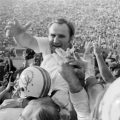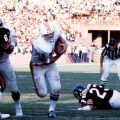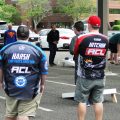Tag Archives: phillyman articles

The Power of Fun – Dave Raymond, The Original Phillie Phanatic

The Phillie Phanatic is the greatest mascot in sports…largely because original Phanatic Dave Raymond simply put on the costume, went out and had fun. I had a chance interviewed Dave, who now creates team mascots as the owner of Raymond Entertainment Group, for the April 2015 issue of JerseyMan. You can view the PDF of the magazine article here.

Dave Raymond, the original Phillie Phanatic, with his best friend. (photo courtesy of Dave Raymond)
The Power of Fun
Imagine being a business owner who is looking to improve your marketing. You want a smart, polished, exciting campaign to bring life into your adequate but unmemorable image. You want to target a younger audience that otherwise might not discover your product.
Needless to say, this problem requires professional expertise, so you call in a consultant.
A consultant who, for much of his adult life, made his living wearing a furry green costume, recklessly riding around in an ATV and thrusting his ample hips at sports officials.
Because if your company is a minor league baseball team, and the idea is to bring more kids to the ballpark, and you want to create a mascot on that basis, hiring the original Phillie Phanatic to handle the design is a no-brainer.
As the man behind arguably the most beloved mascot in sports, who today is the “Emperor of Fun” at Raymond Entertainment Group, Dave Raymond understands the marketing value of a fun diversion.
Even if he learned it by accident.
“The joke was that the Phillies got the kid that was stupid enough to say yes,” Raymond says with a laugh. “I was a student at the University of Delaware. I had my fraternity brothers telling me, ‘they’re gonna kill you, they’re gonna hang you in effigy and set you on fire, and that’s when the Phillies win! When they lose you’re really gonna get in trouble!’
“That first day, I went into Bill Giles’s office and said, ‘Mr. Giles, what do you want me to do?’ A smile came across his face and he said, ‘I want you to have fun.’ I was tearing out of his office thinking, ‘Wow, this is going to be easy,’ and he screamed, ‘G-rated fun!’
“The first night I fell over a railing by accident, and people laughed. So I was thinking, I have to fall down more. Slapstick humor was something I loved, I was a Three Stooges fan, I watched all the cartoons. It was Daffy Duck and Foghorn Leghorn and Three Stooges because that’s what they laughed about.”
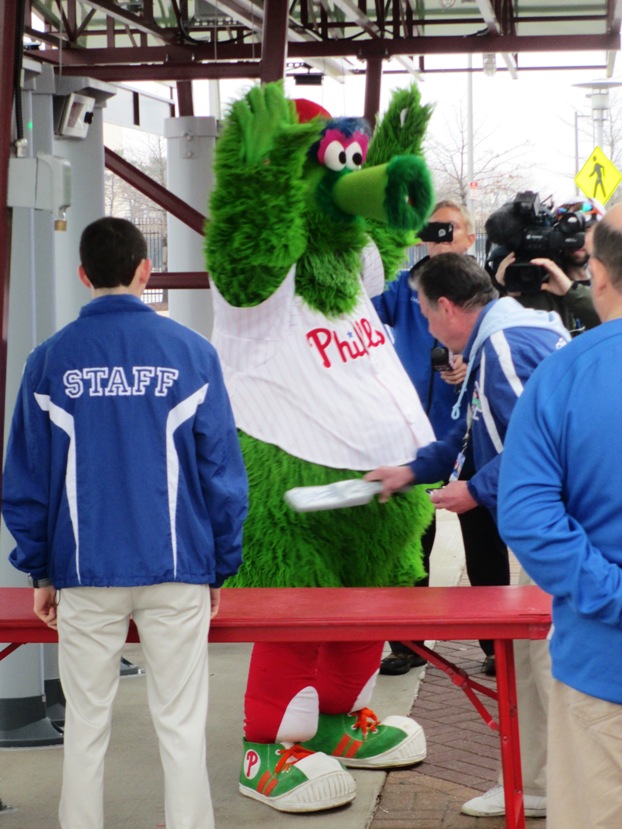
The Phanatic is also always willing to set an example for fellow fans.
Dancing with the grounds crew quickly caught on, too.
“The first night I did that, I tripped one of the guys by accident, the kid tripped and fell, and people laughed. That turned into me running around the bases and at each base I would knock one of the kids over, and then we would all gather behind home plate and dance. Fans were giving us standing ovations, because they’d never seen the grounds crew animated!”
In a rabid and brutally unsentimental sports town, it also didn’t hurt that the Phanatic could so effectively taunt the opposition. Tommy Lasorda, who could often be described as a cartoon character himself, once even wrote a blog post titled “I Hate The Phillie Phanatic”.
Raymond gets along with Lasorda and has read the post. Their feud was usually friendly, but it could escalate: “One night he just snapped, and he came out and tried to beat the ever-lovin’ you-know-what out of the Phanatic.”
The two smoothed it over, but Raymond retains his proud Philadelphian perspective towards the Dodgers icon. “He’s a wonderful ambassador for baseball; the only problem with him is that he’s a Dodgers fan from Philadelphia. Worst type of traitor we could ever have,” he laughs.
“I understood the psyche of the Philadelphia fan. I was one of them! I hated the Mets, I hated the Yankees, I hated the Celtics. And the Dallas Cowboys, to this day, I see Tony Romo in a commercial about pizza and I run and turn the TV off. I knew the fans would cheer when I stepped on a Mets hat or made fun of the Dodgers. I wanted to do that, because I hated the Dodgers, and I hated the Mets!
“It was that type of thing, and you put all those together and make a cartoon character out of it.”

The man and his dream.
(photo courtesy of Dave Raymond)
Today Dave Raymond brings a lifetime of experience as a world-famous character to Raymond Entertainment Group, which designs and builds mascots for sports teams and even corporations.
REG focuses on marketing the Power of Fun. It’s not an easy trick to blend two seemingly opposite concepts like fun and business, but Raymond can speak from solid experience.
“I watched my kids become Phillies fans because of the Phanatic. They wanted to go to games because they had fun. And they learned how to watch baseball and appreciate baseball. My daughters fell in love with the players because they looked cute in baseball uniforms. And now they are not letting me leave when I want to beat the traffic. From a marketing standpoint, the Phanatic’s building baseball fans.”
So in dealing with clients, Raymond emphasizes how valuable—to their bottom line—their furry representative can be. The goofy character in a bird costume is a worthwhile business investment, and for it to pay off, it needs to be done right.
“The first thing we do is make sure they understand the difference between a kid in a costume and a character brand. A character brand is a living, breathing extension of your brand, and a kid in a costume is just that.
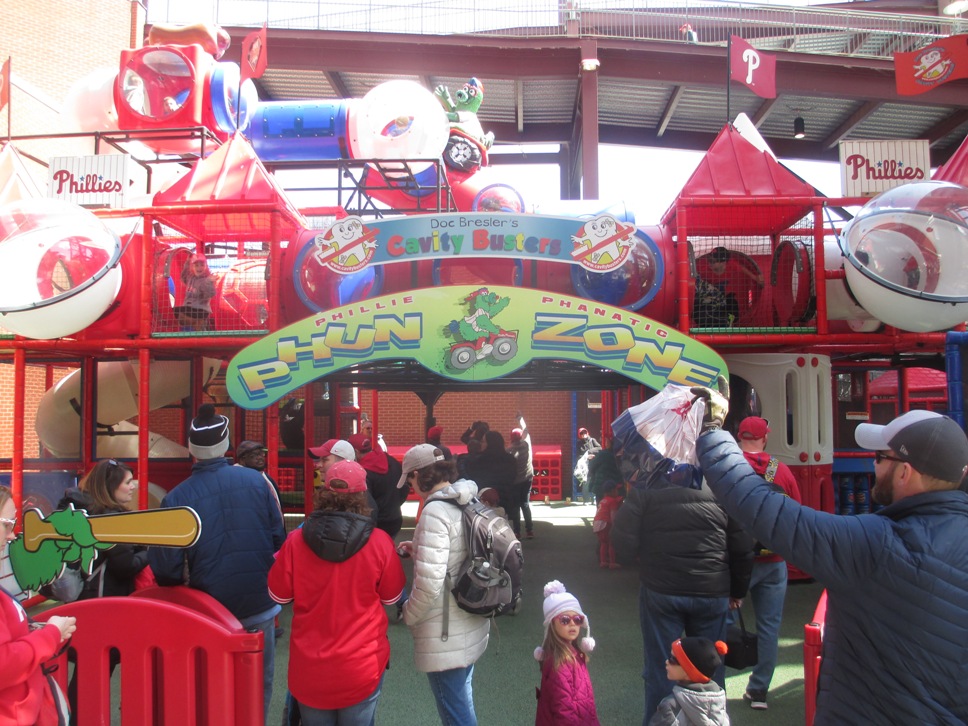
There’s even kids’ play areas dedicated to the Phillies’ enigmatic mascot.
“We research who they are in terms of the organization’s history, and who their community is in terms of the history. We help sketch out a back story that becomes the story of the character.
“They look at designs and they play Mr. Potato Head, they tell us what they like or more importantly what they don’t like, and then we go back and continue to draw until we get a design, we assign the copyright to that design, and then build multiple costumes for them. We help prime performers and train them.
“Also, what are you doing with the character brand? How are you rolling it out? How are you trying to get sponsorships? By the time we roll out the character, they should already know when they’re going to make all their money back, and when they’ll start making a profit.
“If they don’t do due diligence, frankly, I don’t want them as a customer. If they don’t want the best, they’re not gonna value the best.
“There are people saying I need a kid to get in my suit; right away I know that’s probably a client I don’t want. This is a character costume, it’s not a suit. It’s not a kid, it’s a trained performer. If you don’t want that, we’re not the ones for you. It’s a good thing not to waste time trying to make people buy from me. You’re not going to be able to service everybody.”
That’s not to say that REG doesn’t have a long list of satisfied clients; happy customers include the Cincinnati Reds, whose mascot “Gapper” is an REG creation, the Toledo Mud Hens, the Delmarva Shorebirds and the Phillies affiliate Lakewood Blue Claws, among many others. Raymond estimates that REG has created over a hundred characters, including at least ten for corporations.
“What separates us is that no one has the track record of success that we’ve had for not only designing and building, but also helping clients make money, drive revenue and brand, find performers and train them.”
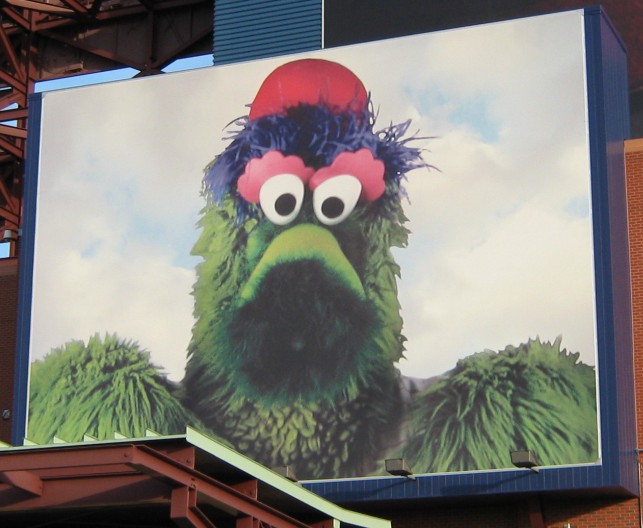
Iconic enough to have his own mural at Citizens Bank Park.
It’s a seemingly natural progression for Raymond: from being an eager young intern who spent sixteen years bringing an inimitable brand of fun to a community, to now supporting a family by showing others how they can do it too.
“I’ve been to a lot of business training seminars, and they always ask what your ‘why’ is. My ‘why’ is, I want my marriage to be great, I want my kids to have good parents, and I want them to grow up and get married and have a great family. Every time I get a check for something, I’m going this is great, now I can pay my salary, and I can invest in what’s important to me, which is my kids and my relationship with my wife.
“Also, I’ve been delivering this presentation, which is the life lesson that the Phanatic has taught me, how powerful fun is to building a family and raising kids or whatever you’re doing. Using fun as a distracting tool is so powerful.
“That’s truly what I love doing more than anything else, getting in front of people and telling these stories and hopefully giving them something that helps them. I’m focused on going into Philadelphia, in the corporate community, and preaching the Power of Fun.”
If anyone knows how to appeal to sports types in the City of Brotherly Love, it’s Dave Raymond. After all, he’s lived it.
“One of the things I miss the most about not working as the Phanatic is the connection to the Philadelphia fan base. Once Phillies fans love you, they love you forever, and it’s almost impossible to do anything to get to the point where they don’t love you.
“That was the beauty of being the Phanatic.”
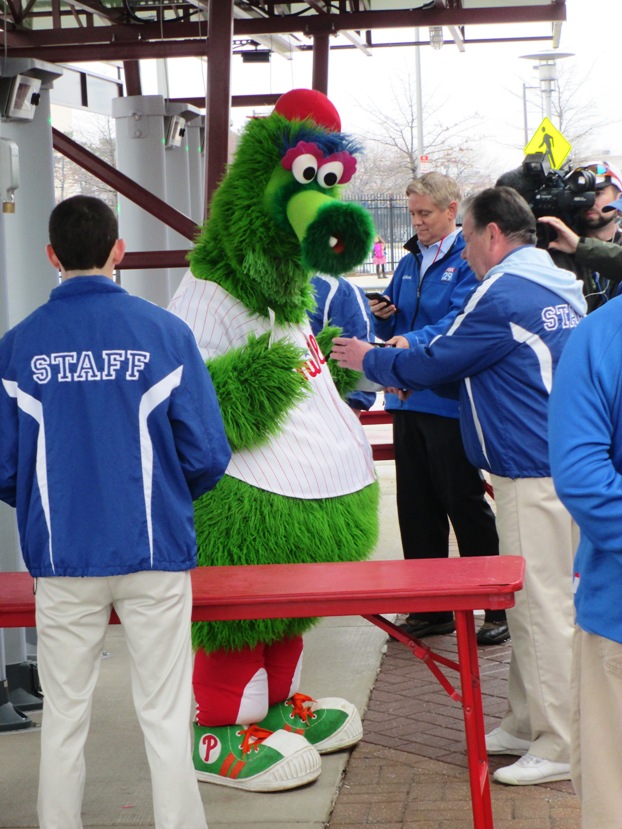
“I’m sorry sir, but your odor is scaring the kids.”
“This Costume Stinks!”
One service that Raymond Entertainment Group offers is costume cleaning…a surprisingly neglected aspect of mascot performance for many teams. The cleaning includes a “State of The Fur” analysis. A performer in a smelly costume is not a pleasant one, as Dave notes.
“The Phanatic opportunity for me, it truly was the best job you could ever imagine. But there were things about it that I hated. I hated that costume getting beer spilled on it, for example. I’m very anal retentive, I can’t stand things out of place, and it just drove me crazy. So I was meticulous about how I cleaned that costume.
“The first year, the people in New York that built it said they couldn’t wash it. You couldn’t even imagine what it smelled like. I finally just threw the thing in my bathtub with Woolite. I thought, I don’t care if I ruin it, it can’t smell like this anymore. When I got done cleaning it, it smelled great, and I wrote a note to the people in New York saying hey, this is how you clean it, and they were like, wow!”
Dave actually will frequently take on the cleaning tasks at REG. “This is what small business is about. I’m cleaning a lot of costumes myself. It’s just something that doesn’t require any great skill; you just spend a little time doing it. I have people that help and clean and restore the costumes. But I jump in there and do it a lot. It’s one of those healthy distractions for my mind.”
The “State of The Fur” analysis is for advice on cleaning and storage. “We try to give them feedback on what we all think they’re doing based on what is wrong with the costume. We want to have our eyes on it, because then our costumes last longer. Then people will say hey, when you get a costume from Raymond Entertainment it lasts for ten years.
“We prefer that rather than make money on rebuilding costumes, although we do that. It’s better that they know that their costume lasts three times longer than the competition.”
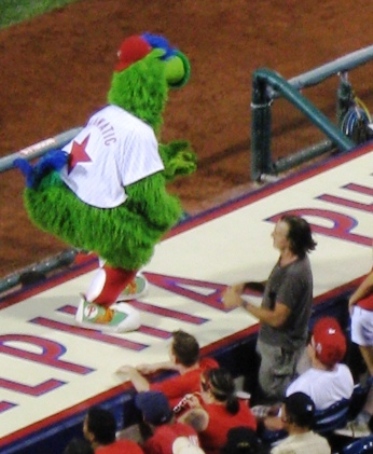
You too can dance on home team dugouts!
Mascot Boot Camp
Although Raymond Entertainment Group trains performers as part of their character creation package, Dave Raymond also hosts “Mascot Boot Camp”, where performers spend a weekend learning all about the business of being a character in a costume and non-verbal communication. It’s for everyone from new mascots learning the trade to longtime performers looking to rehabilitate their skills.
“It’s a great reality experience. If you want to experience what it’s like to be a mascot, come and experience mascot boot camp,” Dave says. “We’ve never marketed it for that, but it’s a lot of fun and they learn to move and communicate non-verbally, they learn how to take care of their costume, and learn how to take care of themselves physically.
“It’s a deep dive into mascot performance, there’s a real method to it now, where once it was Bill Giles telling me to go have fun.”
There’s another important rule of mascot performance: keep it safe.
“Lighting yourself on fire and jumping off a building and crashing into the ground might be something that people will talk about from now until the end of time, but you’re gonna kill yourself. And you’re gonna ruin the costume.”
REG’s “Angel Investor” – Sir Charles
Every business needs capital to get off the ground, and when Dave Raymond sought an investor for his idea to design and build characters, he found what he calls an “angel investor” who is well familiar with Philadelphia sports…Charles Barkley.
“When he would come to the Phillies games,” Raymond says of Sir Charles, “he would have fun with the Phanatic and we did a couple of routines here and there, where he was smacking the Phanatic around. It was fun. Charles invited me to hang out with him and some of his friends in Birmingham when I was doing minor league baseball in Birmingham one weekend.
“I just called him up, and he said my financial guy likes it, I’ll be happy to do it. His financial guy said listen, people haven’t paid Charles back over the years. I said, well, I’m dedicated to paying him back. I haven’t paid him every cent back, but he keeps telling me don’t worry, it’s no big deal. Charles just wanted to help. In the description of an angel investor, Charles Barkley’s picture should be in whatever dictionary or manual that is talking about angel this or that.
“Nobody knows that sort of thing. Charles has done that hundreds of times, he’s just a generous guy, one of the best people on the planet. I’ll be working until I close the business down to make sure he gets every penny back.”

Franklin has worked hard to get where he is today.
(photo courtesy of phillyfamily on Flickr)
Analyzing “Franklin”
Dave Raymond did some consulting for the 76ers in the rollout of their new mascot, a blue dog named Franklin. The humorous back story of Franklin on the 76ers website shows Franklin’s “ancestors” throughout Philadelphia history, including a missing bite out of Wilt Chamberlain’s “100” sign following Wilt’s 100-point game.
Raymond believes Franklin will be a success, despite the recent “controversy” surrounding the character—that Darnell Smith, who wears the Franklin costume, was a Knicks fan.
“One of the things he said to me was, I really need to be a Philadelphia fan, you gotta help me with who the Philadelphia fans are. He worked for MSG, and he was a mascot for the Liberty, the WNBA team. He’s done a lot of work with their performance team, the dunk team, all of that for the Knicks.
“Darnell is an awesome human being and an unbelievably gifted performer. I went to the first game that he was at just a couple of weeks ago and brought my kids, and he was kind enough to come up and interact with us. All the fans in our section were screaming for him. It was for kids by kids, which is what Tim McDermott said he wanted to do.
“What’s nice about it is that he recognized that getting in touch with the psyche of the Philadelphia fan was important. That just shows what a good performer he is. He’s an asset to the 76ers organization, I’m glad they got him.”

Northlandz Miniature Wonderland Railroad Museum

Sometimes JerseyMan lets me come up with my own assignments, so I got to visit Northlandz in Flemington, NJ … the Model Train Capital of the World! This article appeared in the Spring 2020 issue of JerseyMan; click here to see the PDF.

Kind of like the railroad version of the I-295/I-76/I-676/NJ-42 interchange.
All Aboard!
The Northlandz Railroad Museum in Flemington was listed in the Guinness Book of World Records as the world’s largest model railroad. Bruce Williams Zaccagnino’s creation is now the beneficiary of new ownership, an expensive makeover, and finally, the marketing respect it richly deserves.
Julie Parker’s occupation was to tell people about businesses worth visiting in Flemington.
And she had never heard of Northlandz.
That’s roughly the equivalent of being in charge of Philadelphia tourism, and not being aware of Independence Hall, the Liberty Bell, the Art Museum, and the Reading Terminal Market.
It wasn’t Parker’s fault, though. The genius behind Northlandz is an excessively modest man, who cared more about creating his art than promoting it.
She fondly remembers meeting him.
“I was doing the Flemington Information Center. Somebody told me, you’ve got to go see Bruce Williams, he just opened this place called Northlandz. I said, okay, maybe I can promote him. I had a group of businesses that would pay me and I would promote them all over Flemington.
“He actually had me go through it, and I came out and I looked at him and I said, ‘Oh my God, you built this whole place yourself?’”

This is about 1/100th of Northlandz.
If that story is remarkable, it gets better. This phenomenal exhibit of a hobby taken to an unimaginable extreme was almost decimated.
Thankfully, the building fell into the right hands…businessmen with more enthusiasm for putting smiles on faces than for profit.
Tariq Sohail, one of the new owners, was equally shocked and amazed in his first visit to Northlandz. He was minding his own business looking for a storage warehouse, and came upon a large gray building off Route 202 that might work.
“We drove past it so many times. I never knew what it was. Our real estate guy said, if you don’t like what’s inside, you can always demolish it.”
As Sohail describes his reaction to seeing what was inside, Parker chuckles, as if fully appreciating the astonishment factor.
“We started going through the whole tour,” Sohail continues. “We were like, in our lifetime, nobody has ever built something like this. We’ve traveled throughout the world, we’ve never seen anything like this.
“So we decided to take a risk and invest into it and promote it.”
That they’ve done. Northlandz needed work, to be sure…read reviews from a few years ago and you’ll see a lot about the state of disrepair it was in. Sohail and his partners have thus far poured several hundred thousand dollars into cleaning it up, and the results are nothing short of remarkable.
“There are people that came three or four years ago and they say, we can’t believe the difference,” Parker says proudly.
The new ownership has a larger vision for Northlandz too…it includes shuttle buses from New York City, a hotel, a banquet hall, and much more. All revolving around a toy train set.
That said, it is one truly amazeballs train set.

People like to live dangerously here.
Northlandz is, simply put for brevity, the world’s largest model railroad, according to the Guinness folks who are experts on such things. It spans over 45,000 square feet and 16 acres. The walkway just to go through it is over a mile.
To give you an idea of just how staggering its size, this observer had taken over a hundred pictures before reaching a sign that reads: “You are now 25% through Northlandz”.
Every moment is sheer model railroad wonderment. Huge displays filled with mountains and bridges, offering backdrops to bucolic still life of homes, factories, rivers, and neighborhoods. There’s “Iron Valley”, with its multiple iron bridges gracefully leading through mountain tunnels. There’s “Joycetown”, with churches, homes, and model trucks decorated with staples of American commerce like Kodak, Dollar Tree and Valvoline. There’s a fully detailed city mockup featuring an aircraft carrier. And a display of mountain life with busy railroads throughout that literally occupies three floors of the building. Tunnels? Northlandz features over four hundred of them.
On and on and on.

Like a scene from The Fugitive, isn’t it?
Any one of these displays could be the highlight of nearly any museum in the country. You could literally spend hours in one spot, watching a toy locomotive charmingly meander through a perfectly scaled-down neighborhood.
And this marvel was nearly all built by just one person.
Sohail estimates that Zaccagnino spent 17-19 hours daily, seven days a week, for close to four years building a miniature world. As one can imagine, he received little to no support from family members…as if spending eight hours a day and five days a week in a cubicle somehow makes more sense. According to Sohail, only Bruce’s wife Jean always supported the venture.
You could probably be forgiven for thinking your neighbor was crazy for devoting even sleeping hours to building a model railroad.
Then you see the finished work, and you realize crazy people are awesome.
“You won’t believe your eyes” is Northlandz’s slogan, and despite seeing it every day…Parker is currently the Northlandz Marketing and PR Director…she repeats those words herself often, with genuine passion that every employee shares.
“I just feel it’s magical,” she gushes. “How can somebody have conceived this? It’s incredible. You go through it and you start seeing all these little trains going in the little villages and the different themes and the different venues.”
“Everything is built by hand,” Sohail adds. “He told us one of the bridges that he built is 40 foot long, 23,000 small wood pieces, that he put together one by one by one by hand.”

Yes, I would go to church before crossing that bridge too…
Ask anyone working at Northlandz what the appeal of a huge model train set is and you’ll get a different answer.
Parker thinks it’s the glimpse of history.
“I think it goes back to the industrial revolution. Trains made our country great. They transported everything. Food, industry, it’s like the backbone of our economy. Buses, trains and cars, they’re what makes the economy tick.”
Sohail believes the appeal reaches us on multiple levels. He refers to young people who come to work at Northlandz and help with the layouts out of pure passion.
“Within the train layout, you have to have more than one skill. It’s architecture, it’s engineering, it’s electrical, it’s design, it’s scenery. Basically doing one hobby, you’re learning all different skills.”
Ken Vogel, a train technician, generously took time to point out multiple intricacies of Northlandz during this interview. He remembers his own days of building model trains, and bringing one of his fellow hobbyists to Northlandz for the first time.
“Bruce signed a box car that we brought here from my nephew. What I said to him at that time was, I know a lot of people that are remodelers who always wanted to build an empire and never did it. I said, you’re the only one that did.”

Who knew miniature life could be so much fun?
Sohail thinks the moving train gives life to a piece of art. “You’re looking at something beautiful going up and down, and all of a sudden the train comes.”
Worth putting over $300,000 into preserving? No question for Sohail. “Every time I come, it excites me as well, even when I own it. I see the people coming out of the place and I see how big the smiles on their faces and how happy they are to see it.
“That’s made me happy.”
Walking through the magical railroad empire that is Northlandz, one gets a sense of needing to be of advanced age to fully appreciate the endeavor. The longer you’ve spent on Planet Earth, the longer you’ve gone without witnessing anything like it.
But even this observer’s little ones can’t wait to go back.
Did this post make your day a little bit?
I hope so. If it did, I would really appreciate your support.
When you use this link to shop on Amazon, you’ll help subsidize this great website…at no extra charge to you.
Thanks very much…come back soon!

Isn’t “largest miniature railroad” like “light heavyweight”?
If You Go (And You Should)
If you are at least enough of a model train enthusiast to, say, put a little track under your Christmas tree each year, you have to visit Northlandz. In most any search for “largest model railroad in the world” or “largest model train display”, you will find Northlandz in the list.
The most important piece of advice for going is this: devote an entire day to your visit, whether you’re bringing the grandkids or not. You may be able to enjoy all of the exhibits in an hour, or you may want to take more time to fully appreciate the astonishing level of detail…and that can truly take a full afternoon.
There is a kids play area in the middle of the museum, which features an organ that Zaccagnino would play for visitors from time to time. Zaccagnino is retired now, but there is still enough to give the little ones a break before they see the rest of the museum.
You can find a few complaints online that Northlandz is on the pricey side, although it’s well worth every penny in this observer’s opinion. That said, there are online coupons to take a few bucks off of the price…just search for “Northlandz coupon”. Military, teachers and seniors get discounts, and persons with disabilities get in for free.
It’s easy to get to Northlandz in less than an hour or so from the Philly area, but should you need to spend the night, there is a Travel Inn & Suites just steps away down the road, and a Hampton Inn a bit further away in the heart of the shopping area of Flemington. The Hampton tends to get better reviews.
If you’re hungry there’s McDonald’s, Chick-Fil-A, and multiple other restaurants where U.S. 202 meets NJ-31 just a short drive away.
One last thing…if you take the kids, they’re going to want to go back. Not that you’ll mind.
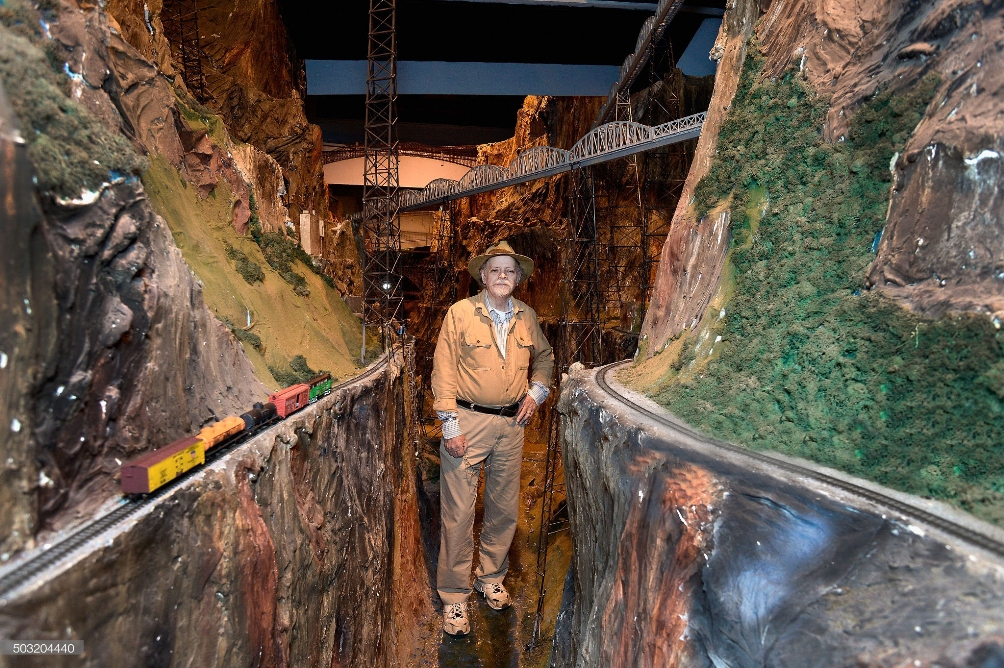
The genius behind it all. (Photo by Paul Marotta/Getty Images)
The Man Who Built It
Bruce Williams Zaccagnino got started in the same place most all model railroad enthusiasts do: in his basement. More correctly, in a basement of a house that was being constructed, according to the Northlandz website. The construction workers would leave for the day, and he would build mountains and tracks in his new basement.
Like today, nearly everyone who saw his work was quite impressed, to the point where he would open it for the public on weekends. He purchased the land on Route 202 as the popularity grew, and the rest is history.
Zaccagnino was no stranger to artistry, incidentally. He made a decent amount of money in the video game industry, including winning several awards as a developer/designer. He was, according to Sohail, quite the accomplished musician as well. “I watched him play the organs that we have over here. I never saw anybody play that well.”
But Northlandz was his passion, obviously. To the point where he spent his time building his dream, rather than marketing it. Sohail compliments his modesty, but expresses regret that his people didn’t meet him sooner.
“We would have promoted this throughout the world,” he says.
“He’s been interviewed with CNN and Fox, all the major, you know, and he never made a big deal out of that. He’s in the Guinness world records, this place, and he never even promoted that fact. We saw the certificate, it’s sitting on the exhibit and anybody could take it.”
“Bruce didn’t really advertise; he let itself advertise,” says Ken Vogel. “The point was, it was a guy who had a dream about building a great layout and actually pulled it off. The dream is accomplished.”
Zaccagnino is retired now…traveling, according to Julie Parker, so one guesses he’s actually riding trains instead of building them. But he’s appreciative that his art is going to live on.
“I think he was starting to see that a lot of stuff was falling apart,” Sohail reflects. “He had a feeling like if somebody doesn’t save it, it’s going to go away. When we bought it and we started repairing it and cleaning up and everything, he was very happy, you know, my art is being preserved.
“He said, this is my gift to the world.”

Expanding His Roots – Jeff Holman, Haddonfield High Tennis
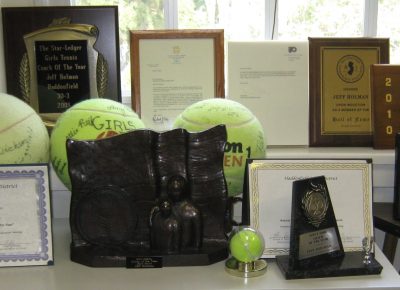
Jeff Holman is a member of the Holman family, a name you’ve heard if you’ve ever shopped for a car in South Jersey. But he’s made his mark coaching high school tennis, with over 2,000 victories to his credit. I interviewed him for the October 2013 issue of JerseyMan. You can view the PDF of this article here.
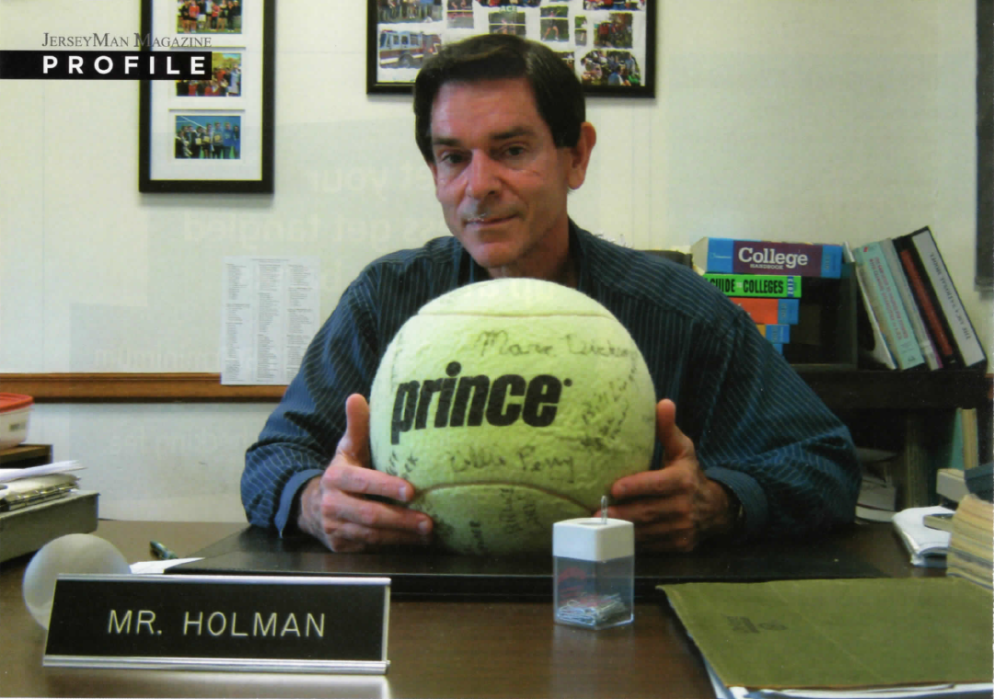
Jeff Holman, the legendary tennis coach at Haddonfield High.
Expanding His Roots
Jeff Holman is a member of the Holman car sales family, but he’s made his own mark in high school tennis coaching.
Mention the name “Holman” to a South Jersey native and chances are a car dealership will come to mind. The name has been selling automobiles in the Garden State for nearly as long as automobiles have existed. Most readers of this publication have probably either bought a car from a Holman or know someone who has.
But over the last three and a half decades, Jeff Holman has achieved what could be called legendary status in a realm that has nothing to do with Cadillacs.
By the time you read this article, Holman, who coaches both girls and boys tennis at Haddonfield High School, will likely have passed an astonishing 2,000 victories—both teams are within striking distance of 1,000 wins each. The boys’ teams have won nine state group championships; the girls’ team has won 18 state group titles and three Tournament of Championship crowns—often against larger schools with bigger talent pools.
He’s gotten quite a bit of recognition himself; 20 Coach of the Year awards, and membership in five Halls of Fame, including Camden County Athletics and the New Jersey High School Hall of Fame, are a small sampling of the countless awards and honors he’s received.
As successful as the family is in car sales, Jeff has proven that the Holmans aren’t a one-trick pony.
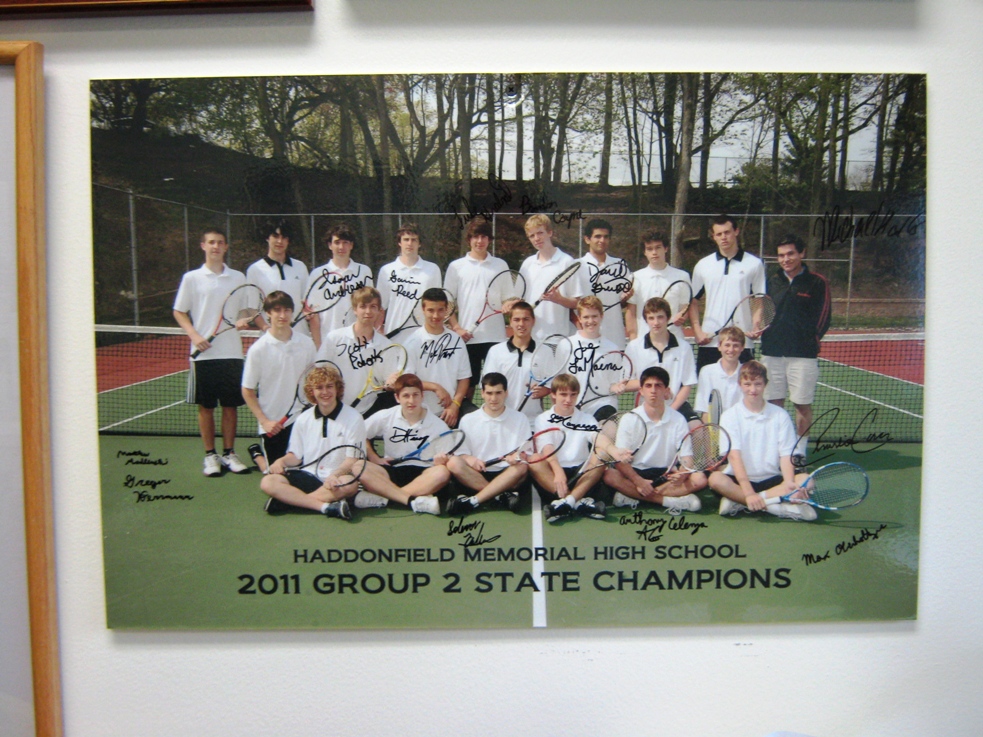
The Group 2 2011 Champions.
As a young lad, Holman probably thought he would sell cars when he grew up. He once wrote a “future career” paper on being a car dealer, which given his background was probably an easy assignment. But he says no undue expectations were placed on him by his Jersey famous family.
“I have two siblings; my sister Mindy is now the CEO of Holman Enterprises, and my brother Steve is a cabinet maker in Dorset, Vermont. Mostly, my parents encouraged me to do what I wanted to do. I had good teachers that encouraged me to get into education.”
Holman was a decent player at Haddonfield High, known for not rushing the net and simply wearing opponents down. But he knew he wasn’t destined for stardom on the court either. He attended college at Princeton, where the talent was, to put it mildly, substantial.
“The #1 varsity player at Princeton (Bill Colson) was ranked ahead of Jimmy Connors. My roommate was a two time Nebraska state champion; he wasn’t even a consistent starter. I was realistic enough, a good high school player, but I never thought I could play professionally.”
After graduating from Princeton, Holman returned to Haddonfield as an English teacher, and served as an assistant coach on the girls’ basketball team. Haddonfield being a small school, there weren’t enough tennis courts for two teams, so the girls’ season was moved to the fall in 1976. Their coach, Ellie Kind, was also the field hockey coach, so Holman took over the tennis team when the two schedules merged.
Two years later, Ken Grabert, the boys’ coach, “decided that driving the bus to events paid more than coaching, which was correct”, and Holman took over the boys’ team. 35 years later, though he’s now a guidance counselor, he is still on the court with young people most afternoons, steadily adding to the impressive win totals and titles.
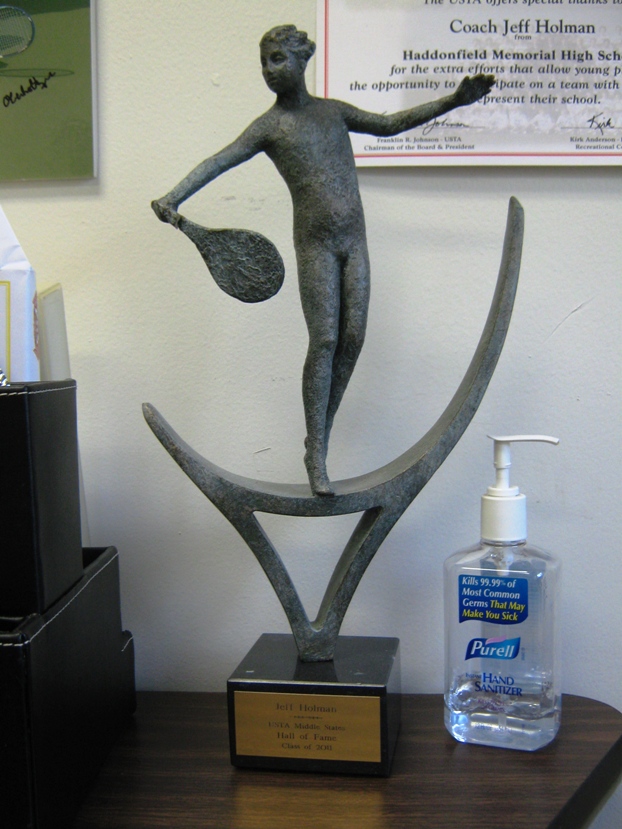
One of many awards found in Jeff Holman’s office.
Leaders in any endeavor will often tell you that success depends on choosing the right personnel. In high school sports, this presents a significant obstacle. Coaches don’t have the option of recruiting the best players from a 500-mile radius. The kids in town are what they’ve got.
In this environment, Holman magnanimously gives some credit for his success to local tennis clubs as a place where parents teach the game to kids. But he also piled another challenge on top of recruitment limitations: a no-cut rule. Every student who signs up will have a chance to represent Haddonfield tennis. Jeff explains the reasoning:
“One of the best players I ever had was a girl named Phoebe Figland, she was part of the 1980 team that won the first ever Tournament of Champions. Back then we had four courts, I had to keep 16 girls, and Phoebe as a freshman was number 17 so I had to cut her. Luckily she wasn’t one of those kids that gets discouraged easily; she came back and earned a starting varsity position, and went on to become a Division I player at the University of Richmond.
“Maybe in Phoebe’s case it gave her more inspiration to become as good as she did. But I think other people might have quit. Since that time I’ve always looked for a way to keep everyone involved and not cut people.”
That means arranging more matches with more teams, which Holman does. “In our program we have 40-50 players, and schools we play against may have 10-15. So by having a lot of matches and a separate rotation system, even though our team is bigger, all of the players get to play in matches. If they are all involved and can have a fun experience and see improvement, they’ll want to keep on playing and getting better.”
If you’re looking to ferret out a nugget from him about how to successfully coach high school sports, that is mostly what Holman will tell you. Keep all the kids involved, having fun, and playing tough competition. Encouragement and positive reinforcement. Not much about fundamentals.
“The mechanics, a lot of that is learned in the offseason. It’s hard to change someone’s mechanics during the season. They might get worse before they get better. There are outstanding professionals in the area that our students have gone to, and these teachers have instilled some mechanical knowledge of the game.”
So instead of teaching backhands or “getting into the zone”, Holman’s focus is on arranging as many matches as he can with quality opponents, and separating practices into groups so that all of the players get time in with the coach.
He even drives the team bus. It’s a gesture that appears to be a show of humility or bonding, but it is actually rooted in practicality: “If the school doesn’t have to pay a driver, then tennis, which has no transportation costs, enables Haddonfield to play an ambitious schedule. We can go to North Jersey or I can schedule more matches in a week. In this era of budget constraints, not having to play a bus driver really frees up our program.”
Whatever it takes. “I think it’s important to convey that this team is very important to me and I’m going to work harder than anyone else. And that whatever I ask the players to do, I’m going to do the same thing or more in terms of commitment.”
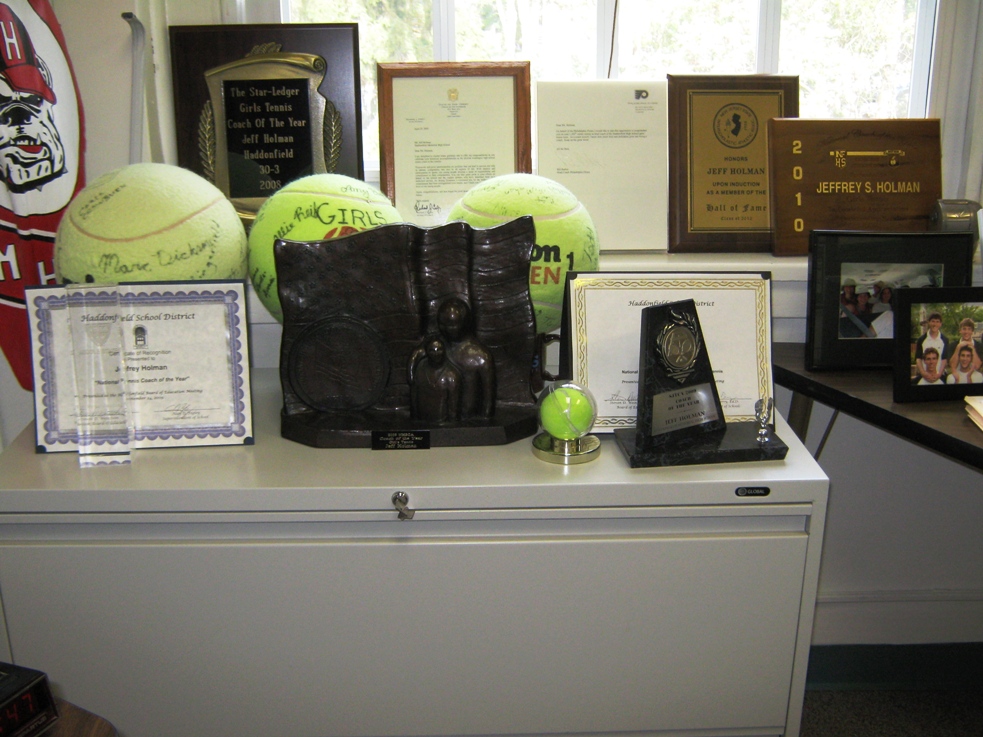
So many awards it almost blocks the window.
Holman’s proudest achievement? After coaching 70-plus seasons, he has trouble picking a favorite memory. “I guess when you do something the first time it stands out. On the girls’ side I think back to a team in 1980, the first year New Jersey held the Tournament of Champions, when the state champions of all the different divisions have a playoff. The 1980 team won that initial tournament. The boys kept falling short in state tournaments; finally in 1983 that group of players was the first Haddonfield team that won a state title.
“Haddonfield has always been a very successful athletic school at everything, but there have only been a couple of teams that have won a Tournament of Champions. The girls’ tennis team has done it three times now. It’s a very rare achievement.”
Holman tempers any appearance of boasting. “It’s nice to win championships, and we’ve done our share of that, but above all we’re trying to instill a love of the sport, and in their later lives they are still playing, and that maybe part of the reason was the Haddonfield program.”
One of the winningest high school sports coaches in the country seems reluctant to suggest that what he does results in more than young people enjoying the game of tennis. But he’s undoubtedly played a role in the character building of many young people. To teach them that they will have a chance to get in the game, to play against the best, and to be able to challenge opponents with unfair advantages and still win, undoubtedly leaves a stamp of confidence on an adolescent mind where self-esteem can often be in short supply.
Especially for a kid that might not have otherwise made a team of 16.
Jeff Holman doesn’t have an apparent personality for car sales. He is a soft spoken, even-keeled fellow, highly regarded by all who know him, but there is still a cauldron of quiet determination in him. If it weren’t for Haddonfield’s reputation as a high school tennis powerhouse, you wouldn’t expect this quiet gentleman to bring a team from a small school that can whip your big school’s behind.
And for several generations of Haddonfield tennis playing alumni, the Holman name means something more than an established place to buy a nice automobile.

The Old Ball Game – SJ Men’s Senior Baseball League
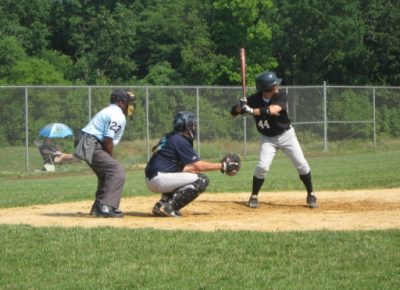
The South Jersey Men’s Senior Baseball League is a haven for men in their advanced years who still can and want to play some baseball. I wrote this piece for the August 2012 issue of JerseyMan; you can view the PDF from the magazine here.
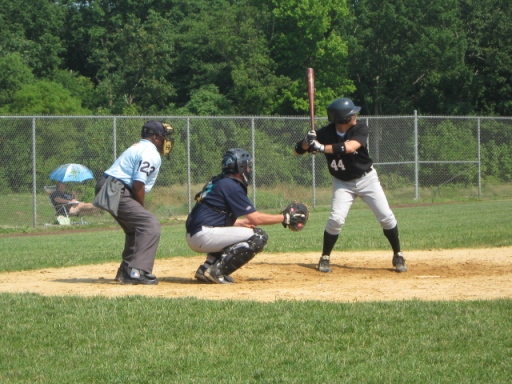
Waiting on the high hard one, adjusting for everything else.
The Old Ball Game
After 20 years, the South Jersey Men’s Senior Baseball League is stronger than ever.
On a picture-perfect Sunday morning at Doc Cramer Field in Manahawkin, the Hammonton Black Sox are playing hooky from church to play baseball, in a time-honored tradition that a Benevolent Supreme Being isn’t likely to mind.
With his team shorthanded, manager Mike Dunleavy must take the field and has enough to keep him busy, so he lets this observer keep score in their game against the Ocean Pirates. At one point a Sox player slaps a weak chop that travels about ten feet but successfully moves the runner on first over to second. There is a dispute over whether it counts as a sacrifice. “You’d be surprised at how much these guys look at their stats,” Dunleavy tells a writer who, as a former softball player, is sure he wouldn’t be surprised at all.
The team has several batters hitting over .400, but they’ve managed little offense in this game. “Junkballers,” the manager says, of his hitters’ performance against the Pirates’ Jeff Martin. “We always have trouble with them.”
In the bottom of the ninth, he calls a conference on the mound with his pitcher Tom King, to figure out how to pitch the Pirates’ Eddie Titley with a runner on second and the game tied. Over King’s objections, Dunleavy orders Titley to be put on intentionally. King, who has pitched a fine game, walks the next two batters, and the Pirates take a 3-2 victory over the Black Sox with two runs in the ninth. Despite its painful obviousness, the manager feels compelled to point it out: “Tough loss.”
Following the game there is a brief shouting match in the dugout between Dunleavy and King over the decision to walk Titley, which is fairly quickly smoothed over. It’s not a contract year, after all.
“From eight to eighty, the game is the same,” Dunleavy says. “It’s still about pitching and defense. There’s nothing I can tell these guys that they don’t already know.”
And so it goes in the senior fast pitch baseball world.
Dunleavy has managed Hammonton’s team in the 45+ American Division for seven years. When his team is shorthanded he will take the field, and occasionally he takes the mound to pitch. At his advanced age, he isn’t stealing bases or hitting bombs or overpowering hitters, but like most pitchers he can still pitch a successful game if he keeps the ball down. The Pirates, he says, are their friendly arch rivals—the Black Sox had lost to them two years before in the championship game, and had beaten them last year for the championship. It’s not Yankees-Red Sox, but it still fires up both teams.

Taking the field in Camden for the All-Star contest.
On July 15 of this year, the South Jersey Men’s Senior Baseball League celebrated its 20th anniversary at Campbell’s Field in Camden. In a brief on-field ceremony, league president Lou Marshall and vice president Neil Hourahan presented league founder Bill Curzie with a plaque, as a thank you for being the indefatigable spark for the SJMSBL and a key ingredient of the glue that has held the league together for 20 years. Whether it is attributable to the league’s success is not certain, but Curzie does not appear to have aged at all in two decades, and at 77 still looks fit enough to play two.
In 1992, at the age of 57, Curzie met up with players of a Pennsylvania division of the MSBL, and asked about setting up a fast pitch baseball league in South Jersey, which had none at the time. National league president Steve Sigler enthusiastically gave Curzie permission, and off he went.
With the help of a story in the Burlington County Times—that began with the words “Curzie is serious”—Curzie spread the word quickly. It turned out that South Jersey was heavily populated with thirty-, forty-, fifty- and even sixty-somethings who still wanted to play ball—and didn’t mind faster pitches or nine innings, the way the game was meant to be played. In less time than it takes a superstar free agent to say “it’s not about the money”, there were enough players for four teams, and the league began with six.
With the help of Curzie’s equally dedicated assistant commissioner Gary Brown, the SJMSBL kept growing, and is now the second largest senior fast pitch league in the nation, with over 1,200 players in four age brackets. There’s been a 25% growth in the 18-year-old group, which bodes well for the long term health of the league. They are adding a 55+ division next season.
Curzie shares the story of his standing firm on the league moving to wooden bats, after the national disgrace of aluminum bats had been the norm for some years in nearly every league. Today, most fast pitch leagues are back to using wooden bats, and Curzie humbly accepts some of the credit for that. When asked the ridiculous question of why wooden bats over aluminum, he has a simple response: “It’s just baseball, man!” He does elaborate further, though. With the reflexes of players at this age, aluminum bats are more dangerous, and besides, there are too many cheap hits with aluminum.
Today Marshall and Hourahan now handle the running of the league. The list of administrative tasks is long. In the beginning of the season, Marshall must be in continuous contact with the national headquarters of the MSBL, ensure that fees are collected, manage schedule changes, work with the umpires’ organization, deal with the inevitable problems that teams will have with the schedule, and arrange the All-Star weekend in Camden.
It’s a lot of work maintaining the league and playing on top of it—a full time job, Marshall admits. It’s all worth it, of course. He echoes the sentiment of the players on the field: “you feel like you’re eight again.”
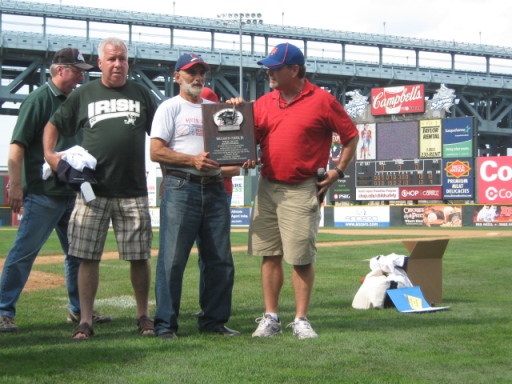
Bill Curzie accepts an award for putting players back on the field again.
There aren’t hot dogs, exploding scoreboards or the roar of the crowds. You won’t see players at the level of Andrew McCutchen or Mark Teixeira here. But you might appreciate, as these fellows do, how difficult it really is to throw out a baserunner attempting to steal or to turn a double play. Dunleavy says, “Hunter Pence can throw out a guy at third base. We would need a couple of extra throws to get the ball there.”
Perhaps, but that’s an exaggeration that doesn’t give credit to the skills many of these fellows have.
They wear uniforms and cleats. They steal bases. They take advantage of fundamental mistakes. They throw the ball around the horn after a strikeout. They use leg braces and pine tar. Balks and infield flies are called. There are rundowns, pickoffs, and lots of spitting. There is pressure to win, real trophies, and real statistics displayed online that people from here to Cambodia can see.
Some players even look for that little bit of rule-bending edge. Marshall tells the story of a pitcher loading a ball with tobacco juice and snot; eventually he even bought a container of K-Y at the store with his wife present—assuring her it was for his “other slider”.
Being an umpire, which pays in the neighborhood of $80 a game, is just as thankless a job as it is at any level of baseball. Players gripe about calls throughout the game, which the ump, who wants to appear professional just as the players do, mostly takes in stride. Between innings an umpire shares stories about rare times where he’s ejected players. One involved a thrown bat making a loud clang; another involved foul language directed at him. But most times, he says, if he’s got to be out in the heat, then so do they.
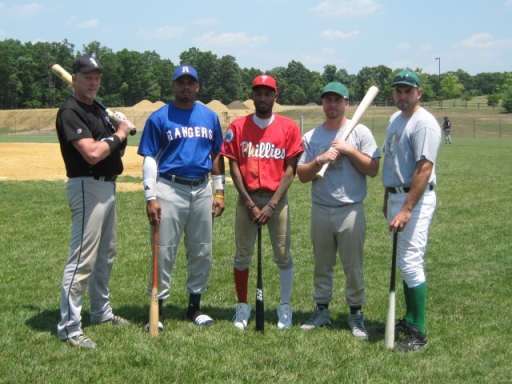
Stars of the league.
The SJMSBL is a haven for men refusing to age—who desire to compete on the highest level they can, relive the playing days of their youth, and many times to do both.
Anyone can sign up and play. It’s a time commitment; players give up a day of their week, in this case a Sunday morning. They’ll need legs too; they’re going to be running the full 90 feet between the bases. Some of them will get hurt in battle; many of the Black Sox’s best are currently on the DL. During the interview, Marshall—who still plays while running the league—shows me elbow scabs from sliding.
Never once does it occur to any of them that none of the games will be on television, that they won’t be driving a Porsche with their contract, or that it’s highly unlikely anyone besides an insurance company will ask for their signature. They are playing a boy’s game again, and loving every second of it. Who wouldn’t leave it all on the field?
Dunleavy remarks: “I have seen in the faces of the older guys what men’s senior baseball has done for their spirit. They never thought that they would ever get the chance to actually suit up and play competitively again.”
From eight to eighty, the love of the game is the same too.

